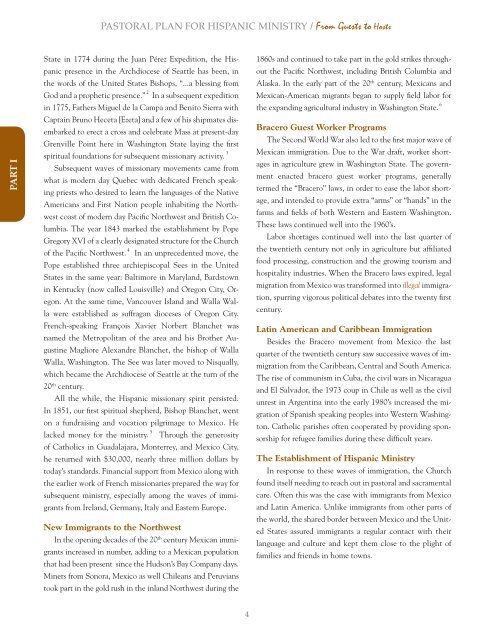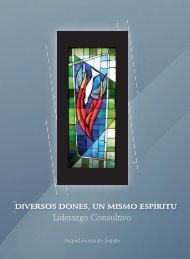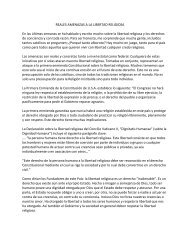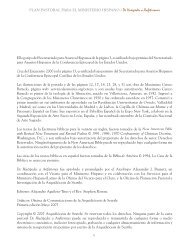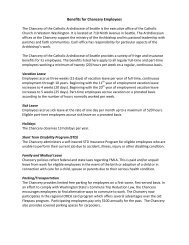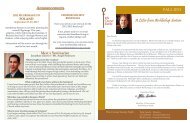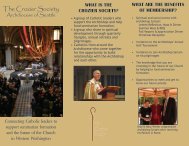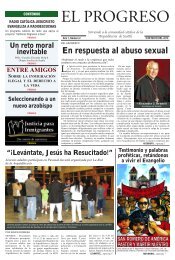Pastoral Plan for HisPanic Ministry / From Guests to Hosts Hispanic ...
Pastoral Plan for HisPanic Ministry / From Guests to Hosts Hispanic ...
Pastoral Plan for HisPanic Ministry / From Guests to Hosts Hispanic ...
You also want an ePaper? Increase the reach of your titles
YUMPU automatically turns print PDFs into web optimized ePapers that Google loves.
<strong>Pas<strong>to</strong>ral</strong> <strong>Plan</strong> <strong>for</strong> <strong>Hispanic</strong> <strong>Ministry</strong> / <strong>From</strong> <strong>Guests</strong> <strong>to</strong> <strong>Hosts</strong>PART IState in 1774 during the Juan Pérez Expedition, the <strong>Hispanic</strong>presence in the Archdiocese of Seattle has been, inthe words of the United States Bishops, “...a blessing fromGod and a prophetic presence.” 2 In a subsequent expeditionin 1775, Fathers Miguel de la Campa and Beni<strong>to</strong> Sierra withCaptain Bruno Heceta [Ezeta] and a few of his shipmates disembarked<strong>to</strong> erect a cross and celebrate Mass at present-dayGrenville Point here in Washing<strong>to</strong>n State laying the firstspiritual foundations <strong>for</strong> subsequent missionary activity. 3Subsequent waves of missionary movements came fromwhat is modern day Quebec with dedicated French speakingpriests who desired <strong>to</strong> learn the languages of the NativeAmericans and First Nation people inhabiting the Northwestcoast of modern day Pacific Northwest and British Columbia.The year 1843 marked the establishment by PopeGregory XVI of a clearly designated structure <strong>for</strong> the Church4of the Pacific Northwest.In an unprecedented move, thePope established three archiepiscopal Sees in the UnitedStates in the same year: Baltimore in Maryland, Bards<strong>to</strong>wnin Kentucky (now called Louisville) and Oregon City, Oregon.At the same time, Vancouver Island and Walla Wallawere established as suffragan dioceses of Oregon City.French-speaking François Xavier Norbert Blanchet wasnamed the Metropolitan of the area and his Brother AugustineMagliore Alexandre Blanchet, the bishop of WallaWalla, Washing<strong>to</strong>n. The See was later moved <strong>to</strong> Nisqually,which became the Archdiocese of Seattle at the turn of the20 th century.All the while, the <strong>Hispanic</strong> missionary spirit persisted.In 1851, our first spiritual shepherd, Bishop Blanchet, wen<strong>to</strong>n a fundraising and vocation pilgrimage <strong>to</strong> Mexico. He5lacked money <strong>for</strong> the ministry.Through the generosityof Catholics in Guadalajara, Monterrey, and Mexico City,he returned with $30,000, nearly three million dollars by<strong>to</strong>day’s standards. Financial support from Mexico along withthe earlier work of French missionaries prepared the way <strong>for</strong>subsequent ministry, especially among the waves of immigrantsfrom Ireland, Germany, Italy and Eastern Europe.New Immigrants <strong>to</strong> the NorthwestIn the opening decades of the 20 th century Mexican immigrantsincreased in number, adding <strong>to</strong> a Mexican populationthat had been present since the Hudson’s Bay Company days.Miners from Sonora, Mexico as well Chileans and Peruvians<strong>to</strong>ok part in the gold rush in the inland Northwest during the1860s and continued <strong>to</strong> take part in the gold strikes throughoutthe Pacific Northwest, including British Columbia andAlaska. In the early part of the 20 th century, Mexicans andMexican-American migrants began <strong>to</strong> supply field labor <strong>for</strong>6the expanding agricultural industry in Washing<strong>to</strong>n State.Bracero Guest Worker ProgramsThe Second World War also led <strong>to</strong> the first major wave ofMexican immigration. Due <strong>to</strong> the War draft, worker shortagesin agriculture grew in Washing<strong>to</strong>n State. The governmentenacted bracero guest worker programs, generallytermed the “Bracero” laws, in order <strong>to</strong> ease the labor shortage,and intended <strong>to</strong> provide extra “arms” or “hands” in thefarms and fields of both Western and Eastern Washing<strong>to</strong>n.These laws continued well in<strong>to</strong> the 1960’s.Labor shortages continued well in<strong>to</strong> the last quarter ofthe twentieth century not only in agriculture but affiliatedfood processing, construction and the growing <strong>to</strong>urism andhospitality industries. When the Bracero laws expired, legalmigration from Mexico was trans<strong>for</strong>med in<strong>to</strong> illegal immigration,spurring vigorous political debates in<strong>to</strong> the twenty firstcentury.Latin American and Caribbean ImmigrationBesides the Bracero movement from Mexico the lastquarter of the twentieth century saw successive waves of immigrationfrom the Caribbean, Central and South America.The rise of communism in Cuba, the civil wars in Nicaraguaand El Salvador, the 1973 coup in Chile as well as the civilunrest in Argentina in<strong>to</strong> the early 1980’s increased the migrationof Spanish speaking peoples in<strong>to</strong> Western Washing<strong>to</strong>n.Catholic parishes often cooperated by providing sponsorship<strong>for</strong> refugee families during these difficult years.The Establishment of <strong>Hispanic</strong> <strong>Ministry</strong>In response <strong>to</strong> these waves of immigration, the Churchfound itself needing <strong>to</strong> reach out in pas<strong>to</strong>ral and sacramentalcare. Often this was the case with immigrants from Mexicoand Latin America. Unlike immigrants from other parts ofthe world, the shared border between Mexico and the UnitedStates assured immigrants a regular contact with theirlanguage and culture and kept them close <strong>to</strong> the plight offamilies and friends in home <strong>to</strong>wns.4


